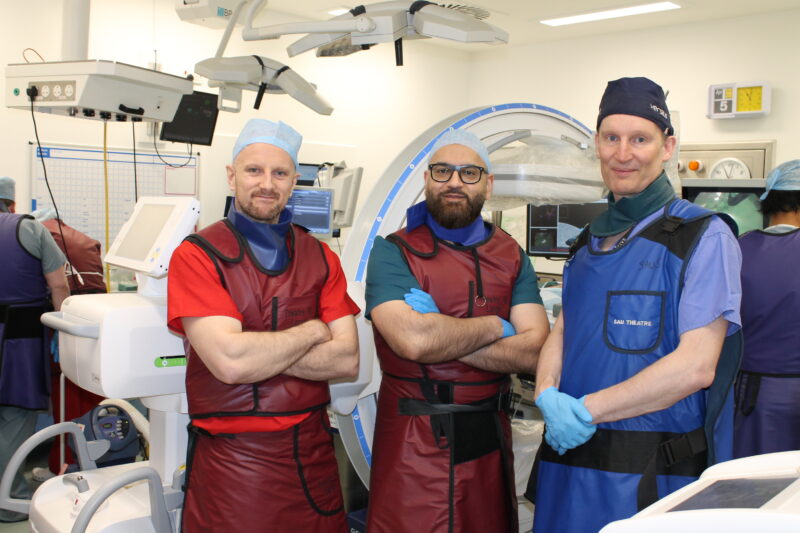Latest collaboration between cardiothoracic surgery and respiratory medicine teams puts trust at leading edge of lung cancer treatment.
A new leading-edge procedure for the minimally invasive sampling of possible lung cancers is being offered at The James Cook University Hospital, thanks to a successful collaboration between respiratory consultant Rehan Mustafa and cardiothoracic surgeon Joel Dunning.
In response to the high number of lung cancer cases across the region served by the South Tees Hospitals NHS Foundation Trust, the pair put together a successful business case to invest in innovative new equipment, which offers a safer way to sample tiny “spots” on the lungs.
The procedure, which is only offered in a handful of hospitals across England, involves the insertion of a small tube into the lungs via the mouth, while the patient is under a general anaesthetic.
Having the equipment at the Middlesbrough hospital means biopsies on lung abnormalities can be carried out up to six months sooner than they would using longstanding NHS pathways, resulting in earlier detection of lung cancer and making curative treatment more likely.
The procedure also significantly reduces risks associated with traditional methods for obtaining lung biopsies – and in six months’ time the hospital will also have the ability to use the equipment to ablate (remove) lung tumours from within the lung, rather than using radiotherapy treatment.

Dr Mustafa explains: “Traditionally after a patient has been identified as having spots on the lungs, the process has been to wait three to six months before scanning patients again, to see if the spots have grown.
“Now we are able to go in and sample them straight away – and in six months’ time, we will also be able to ablate them using this method.
“This will mean that we are able to detect and treat lung cancers much earlier than we have been able to before. It will save many lives.”
Joel Dunning added: “We have put together a fabulous team of respiratory physicians from South Tees Hospitals and North Tees Hospital, consultant radiologists and surgeons to deliver this – and when we start the ablation programme it will be only the second programme in the country.”
Speaking of the improved patient safety when using the new technique compared to longstanding surgical procedures, Dr Mustafa adds: “Traditionally, we had to numb the chest area and insert a needle through the chest wall to sample any spots from the lung that we were suspicious of.
“Doing that comes with certain risks, especially for people with lung diseases, as it can result in lung collapse.
“Using this new technique, the risk of lung collapse and bleeding in the lung is low and if it does happen, we can control it because we are inside the bleeding tubes.”
Innovative software
Dr Mustafa uses the analogy of a car driving into woods to describe the cleverness of the innovative software that creates a “roadmap” of the complex lung structures, enabling the surgeon carrying out the biopsy procedure to get to the exact spot they need to sample.
He says: “If you were to drive in the woods, you could only take your car so far, then you would have to stop because it’s too dense.
“Traditionally a camera only enables us to sample abnormalities located within the breathing tubes but using the software which generates a roadmap to the target lesion, we can now access the lesions situated deep within the spongy bits of the lungs but outside the breathing tubes.”
He believes South Tees’ success rate with the procedure will be a lot higher than the few other hospitals that offer it, because the use of the Cios Spin portable CT scanner enables the surgeon to see, in real time, exactly where the needle taking the sample is going in.
“Traditionally, people would need surgery for their cancers and some of these patients are very frail.
“Instead of targeted radiotherapy we will be able to “zap” it from inside the tubes – and this will be a safer and more accurate way of treating cancers.”
Other uses for the technique in the future will include using special dyes to stain lung nodules requiring surgery, so that a surgeon can go exactly where needed.
This will significantly reduce the patient’s time in surgery, improving patient safety by reducing the risks associated with surgery, especially for patients who are only able to have a lower dose of anaesthetic.
Lung cancer screening service
These innovative new services from South Tees go hand in hand with the trust’s targeted lung cancer screening service, which has recently seen some screening centres pop up in supermarket car parks, enabling consultants to identify patients with spots on the lungs at a very early stage.
GPs across the region are now actively referring at risk patients to the service, and this in itself is resulting in a large number of lung cancers being picked up at a much earlier stage, when successful treatment is much more likely.
Dr Mustafa says: “I’m very proud of the way our two teams have worked together – this is not the first project we have done joint work on.
Three procedures to sample possible lung cancers using the new technique have now been completed.
Attracting high calibre clinicians
Dr Mustafa hopes having the service at James Cook will also enable the trust to continue attracting high calibre clinicians – something that will continue to benefit patients for years to come.
“We believe good quality clinicians will want to come here to learn how to use this technique before they become a consultant,” he said.
“In this way, we are really raising the profile of the unit, the hospital and the trust.”
